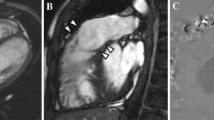Abstract.
In the past 15 years, cardiovascular magnetic resonance (MR) has evolved into an imaging technique that provides adequate, and in part unique, information on residual problems in the follow-up of patients operated for tetralogy of Fallot. Spin-echo or gradient-echo cine magnetic resonance imaging allow detailed assessment of intracardiac and large vessel anatomy, which is particularly helpful in Fallot patients with residual abnormalities of right ventricular outflow and/or pulmonary artery. Multisection gradient-echo cine MRI can be used to obtain accurate measurements of biventricular size, ejection fraction, and wall mass. This allows serial follow-up of biventricular function. MR velocity mapping is the only imaging technique available that provides practical quantification of pulmonary regurgitation volume. MR velocity mapping can also be used to quantify right ventricular diastolic function in the presence of pulmonary regurgitation.
Similar content being viewed by others
Author information
Authors and Affiliations
Rights and permissions
About this article
Cite this article
Helbing, W., de Roos, A. Clinical Applications of Cardiac Magnetic Resonance Imaging After Repair of Tetralogy of Fallot. Pediatr Cardiol 21, 70–79 (2000). https://doi.org/10.1007/s002469910009
Published:
Issue Date:
DOI: https://doi.org/10.1007/s002469910009




